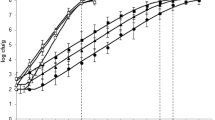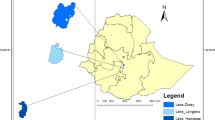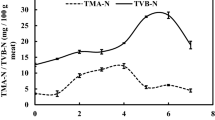Abstract
The current study was undertaken to enumerate Gram-positive bacteria in fresh sub-tropical marine fish and determine the effect of ambient storage (25°C) on the Gram-positive bacterial count. Total and Gram-positive bacteria were enumerated in the muscles, gills and gut of fresh and stored Pseudocaranx dentex, Pagrus auratus and Mugil cephalus on tryptone soya agar (TSA) and TSA with 0.25% phenylethyl alcohol (PEA), respectively. Initial studies indicated that PEA significantly reduced total aerobic bacterial count (TABC) whereas control Gram-positive bacteria were not affected by 0.25% PEA. TABC significantly increased in all fish body parts, whereas Gram-positive aerobic bacterial count (GABC) significantly increased only in the muscles and gills during ambient storage for 15 h. The TABC of the fish species increased from 4.00, 6.13 and 4.58 log cfu g−1, respectively in the muscles, gills, and gut to 6.31, 7.31 and 7.23 log cfu g−1 by the end of storage. GABC increased from 2.00, 3.52 and 2.20 log cfu g−1 to 4.70, 5.85 and 3.36 log cfu g−1. Within each species, TABC were significantly higher in the gills compared to that of muscles and gut; however, no significant differences were found in GABC between muscles and gills. This study demonstrated the potential importance of Gram-positive bacteria in sub-tropical marine fish and their spoilage.





Similar content being viewed by others
References
Ababouch L, Afilal M, Benabdeljelil H et al (1991) Quantitative changes in bacteria, amino acids and biogenic amines in sardine (Sardina pilchardus) stored at ambient temperature (25–28°C) and in ice. Int J Food Sci Technol 26:297–306
Ababouch L, Souibri L, Rhaliby K et al (1996) Quality changes in sardines (Sardina pilchardus) stored in ice and at ambient temperature. Food Microbiol 13:123–132
Al Harbi A, Uddin N (2003) Quantitative and qualitative studies on bacterial flora of hybrid tilapia (Oreochromis niloticus × O. aureus) cultured in earthen ponds in Saudi Arabia. Aquac Res 34:43–48
Ananthalakshmy V, Ramesh A, Venugopalan V (1990) Bacterial production of histamine in some tropical fish. Microbios 63:71–77
Ashenafi M, Abebe Y, Dadebo E (1995) Microbial spoilage of a fresh water fish (Oreochromis niloticus) at low (4°C) and ambient (25°C) temperatures. Trop Sci 35:395–400
Austin B (2002) The bacterial microflora of fish. Scientific World Journal 2:558–572
Austin B (2006) The bacterial microflora of fish, revised. Scientific World Journal 6:931–945
Babajide O, Etanuoma O (2004) Storage life of croaker (Pseudotholitus senegalensis) in ice and ambient temperature. African J Biomed Res 7:13–17
Barile L, Milla A, Reilly A et al (1985) Spoilage patterns of mackerel (Rastrelliger faughni Matsui) 2. Mesophilic and psychrophilic spoialge. Asean Food J 1(3):121–126
Basti A, Misaghi A, Salehi T et al (2006) Bacterial pathogens in fresh, smoked and salted Iranian fish. Food Control 17:183–188
Beri H, James M, Solanki K (1989) Bacterial flora of some fishes of Maharashta and Saurashtra coastal (India). J Food Sci Technol 26(6):318–321
Berrah G, Konetzka W (1962) Selective and reversible inhibition of the synthesis of bacterial deoxyribonucleic acid by phenethyl alcohol. J Bacteriol 83:738–744
Beveridge T, Matias V (2006) Ultrastructure of Gram-positive cell walls. In: Fischetti V, Novick R, Ferretti J, Portnoy D, Rood J (eds) Gram-positive Pathogens, vol 2. ASM Press, Washington DC
Bhowmik T, Marth E (1988) Protease and peptidase activity of Micrococcus species. J Dairy Sci 71(9):2358–2365
Buller N (2004) Bacteria from Fish and other Aquatic Animals. CABI Publication, Oxfordshire
Castell C, Greenough M (1957) The action of Pseudomonas on fish muscle: 1. Organisms responsible for odours produced during incipient spoilage of chilled fish muscle. J Fish Res Bd Can 14(4):617–625
Chang K, Chang J, Shiau C et al (1998) Biochemical, microbiological, and sensory changes of sea bass (Lateolabrax japonicus) under partial freezing and refrigerated storage. J Agric Food Chem 46(2):682–686
Chrisolite B, Sugumar G, Velayutham P (2006) Microbiological quality of fish landed along Thoothukudi coast. J Food Sci Technol 43(1):96–100
Corre J, Lucchini J, Mercier G et al (1990) Antibacterial activity of phenethyl alcohol and resulting membrane alterations. Res Microbiol 141:483–497
Devaraju A, Setty T (1985) Comparative study of fish bacteria from tropical and cold/temperate marine fish. FAO Fish Rep 317(Suppl 474):97–107
Disney J (1976) Spoilage of fish in tropics. Paper presented at the 1st annual tropical and subtropical fisheries technology conference in the Americas, College Station TX, 1976
Estrada M, Olympis M, Mateo R et al (1985) Mesophilic spoilage of whiting (Sillago maculata) and tilapia (Oreochromis niloticus). FAO, Rome, pp 133–135
Fraud S, Rees E, Mahenthiralingam E et al (2003) Aromatic alcohols and their effect on Gram-negative bacteria, cocci, and mycobacteria. J Antimicrob Chemother 51:1435–1436
Garcia-Varona M, Santos E, Jaime I et al (2000) Characterization of Micrococcaceae isolated from different varieties of chorizo. Int J Food Microbiol 54:189–195
Gillespie N, MacRae I (1975) The bacterial flora of some Queensland fish and its ability to cause spoilage. J Appl Bacteriol 39:91–100
Gischler E, Lomando A, Alhazeem S et al (2005) Coral climate proxy data from a marginal reef area, Kuwait, northern Arabian-Persian Gulf. Palaeogeogr, Palaeoclimatol, Palaeoecol 228:86–95
Gram L (1993) Inhibitory effect against pathogenic and spoilage bacteria of Pseudomonas strain isolated from spoiled and fresh fish. Appl Environ Microbiol 59(7):2197–2203
Guizani N, Al-Busaidy M, Al-Belushi I et al (2005) The effect of storage temperature on histamine production and the freshness of yellowfin tuna (Thunnus albacares). Food Res Int 38:215–222
Halebian S, Harris B, Finegold S et al (1981) Rapid method that aids in distinguishing Gram-positive from Gram-negative anaerobic bacteria. J Clinic Microbiol 13(3):444–448
Harrigan W (1998) Laboratory methods in food microbiology, vol. 3. Academic Press, California
International Commission on Microbiological Specifications for Foods (ICMSF) (1978) Microorganisms in foods 1. Their significance and methods of enumeration, vol. 2. University of Toronto Press, Toronto
International Commission on Microbiological Specifications for Foods (ICMSF) (1986) Microorganisms in food. 2. Sampling for microbiological analysis: principles and specific application, vol 2. University of Toronto Press, Buffalo, NY
Jeyasekaran G, Karunasagar I, Karunasagar I (1996) Incidence of Listeria spp. in tropical fish. Int J Food Microbiol 31:333–340
Kamiyama T, Yamauchi H, Iwai T et al (2005) Comparison of environmental conditions in two representative oyster farming areas: Hiroshima Bay, western Japan and Oginohama Bay (a branch of Ishinomaki Bay), northern Japan. Fish Sci 71:1295–1303
Karunasagar I, Karunasagar I (2000) Listeria in tropical fish and fishery products. Int J Food Microbiol 62:177–181
Kim S, Field K, Chang D et al (2001) Identification of bacteria crucial to histamine accumulation in Pacific mackerel during storage. J Food Prot 64(10):1556–1564
Konosu S, Watanabe K, Shimizu T (1974) Distribution of nitrogenous constituents in the muscle extracts of eight species of fish. Bull Japan Soc Sci Fish 40(9):909–915
Lakshmanan R, Shakila R, Jeyasekaran G (2002) Survival of amine-forming bacteria during the ice storage of fish and shrimp. Food Microbiol 19:617–625
Lee J, Cho K, Yook H et al (2002) The effect of Gamma irradiation on the stability and hygienic quality of semi-dried Pacific saury (Cololabis seira) flesh. Rad Phys Chem 64:309–315
Len P (1987) Mesophilic spoilage of marine fish: bay trout (Arripis trutta), bream (Acanthopagrus butcheri) and mullet (Aldrichetta forsteri). Food Technol Aus 39(6):277–282
Lilley B, Brewer J (1953) The selective antibacterial action of phenylethyl alcohol. J Am Pharm Assoc sci ed 42:6–8
Lucchini J, Corre J, Cremieux A (1990) Antibacterial activity of phenolic compounds and aromatic alcohols. Res Microbiol 141:499–510
Lucchini J, Bonnaveiro N, Cremieux A et al (1993) Mechanism of bactericidal action of phenethyl alcohol in Escherichia coli. Curr Microbiol 27:295–300
Mallep (1994) Bacterial microflora in marine fish and evaluation of spoilage. Rec de Med Vet 170(2–3):147–157 (only abstract in English)
Manju S, Jose L, Gopal T et al (2007) Effects of sodium acetate dip treatment and vacuum-packaging on chemical, microbiological, textural and sensory changes of pearlspot (Etroplus suratensis) during chill storage. Food Chem 102:27–35
Montel M, Reitz J, Talon R et al (1996) Biochemical activities of micrococcaceae and their effects on the aromatic profiles and odours of a dry sausage model. Food Microbiol 13:489–499
Nimrat S, Siriboonlamom S, Zhang S et al (2006) Chilled storage of white shrimp (Litopenaeus vannamei) spermatophores. Aquaculture 261:944–951
Omar N (2002) Indole as an index of spoilage of mackerel (Rastrelliger kanagurta) during storage at ambient temperature and in ice. Fish Technol 39(2):142–145
Papadopoulou C, Economou E, Zakas G et al (2007) Microbiological and pathogenic contaminants of seafood in Greece. J Food Qual 30:28–42
Pons-Sanchez-Cascado S, Bover-Cid S, Veciana-Nogues T et al (2005) Amino acid decarboxylase activity of bacteria isolated from ice-preserved anchovies. Eur Food Res Technol 220:312–315
Pons-Sanchez-Cascado S, Vidal-Carou M, Nunes M et al (2006) Sensory analysis to assess the freshness of Mediterranean anchovies (Engraulis encrasicholus) stored in ice. Food Cont 17:564–569
Rajan S (2003) Genetics and physiology of microbes. Anmol Publications, New Delhi (India)
Rantsiou K, Iacumin L, Cantoni C et al (2005) Ecology and characterization by molecular methods of Staphylococcus species isolated from fish sausage. Int J Food Microbiol 97:277–284
Rodriguez M, Nunez F, Cordoba J et al (1998) Evaluation of proteolytic activity of micro-organisms isolated from dry cured ham. J Appl Microbiol 85:905–912
Rodtong S, Nawong S, Yongsawatdigul J (2005) Histamine accumulation and histamine -forming bacteria in Indian anchovy (Stolephorus indicus). Food Microbiol 22:475–482
Rüger H, Hentzschel G (1980) Mineral salt requirements of Bacillus globisporus subsp marinus strain. Arch Microbiol 126:83–86
Ryder J, Buisson D, Scott D et al (1984) Storage of New Zealand jack mackerel (Trachurus novae zelaniae) in ice: chemical, microbiological, and sensory assessment. J Food Sci 49:1453–1456, 1477
Seltmann G, Holst O (2002) The bacterial cell wall. Springer, Berlin
Shewan J (1971) The microbiology of fish and fishery products—a progress report. J Appl Bacteriol 34(2):299–315
Shewan J (1977) The bacteriology of fresh and spoiling fish and the biochemical changes induced by bacterial action. Paper presented at the conference on handling, processing, and marketing of tropical fish, Tropical Products Institute, UK, 1977
Shigi Y (1989) Inhibition of bacterial isoprenoid synthesis by fosmidomycin, a phosphonic acid-containing antibiotic. J Antim Chemo 24:131–145
Silver S, Wendt L (1967) Mechanism of action of phenethyl alcohol: breakdown of the cellular permeability barrier. J Bacteriol 93(2):560–566
Skrodenyte-Arbaclauskiene V (2005) Antibacterial abilities of intestinal microflora in cultured and wild Atlantic salmon (Salmo salar L) fry. Acta Zool Litu 15(4):355–360
Sousa J, Silva-Souza A (2001) Bacterial community associated with fish and water from Congonhas River, Sertaneja, Parana, Brazil. Braz Arch Biol Technol 44(4):373–381
Stevens H, Brinkhoff T, Rink B et al (2007) Diversity and abundance of Gram positive bacteria in a tidal flat ecosystem. Environ Microbiol 9(7):1810–1822
Sudha K, Thampuran N, Surendran P (2002) Prevalence of Vibrio species on fish from pelagic and demersal habitats. Fish Technol 39(2):150–154
Sugita H, Miyajima C, Kobiki Y et al (1990) The daily fluctuation and inter-individual variation of the faecal flora of carp, Cyprinus carpio L. J Fish Biol 36:103–105
Sugita H, Okano R, Suzuki Y et al (2002) Antibacterial abilities of intestinal bacteria from larval and juvenile Japanese flounder against fish pathogens. Fish Sci 68:1004–1011
Sugita H, Kurosaki M, Okamura T et al (2005) The culturability of intestinal bacteria of Japanese coastal fish. Fish Sci 71:956–958
Uddin M, Ahmad M, Tanaka M et al (2001) Bacteriological changes of Indian Shad (Tenualosa ilisha) during ice storage. J Food Sci Technol 38(6):639–642
Vivekanandhan G, Hatha A, Lakshmanaperumalsamy P (2005) Prevalence of Aeromonas hydrophila in fish and prawns from the seafood market of Coimbatore, South India. Food Microbiol 22:133–137
Acknowledgement
The authors thank Joy Miguel for her technical assistance with microbiological techniques and Delma Greenway for her assistances in analyzing the data.
Author information
Authors and Affiliations
Corresponding author
Rights and permissions
About this article
Cite this article
Al Bulushi, I.M., Poole, S., Deeth, H.C. et al. Quantitative assessment of total and Gram-positive aerobic bacteria in fresh and ambient-temperature-stored sub-tropical marine fish. World J Microbiol Biotechnol 24, 1867–1875 (2008). https://doi.org/10.1007/s11274-008-9687-5
Received:
Accepted:
Published:
Issue Date:
DOI: https://doi.org/10.1007/s11274-008-9687-5




